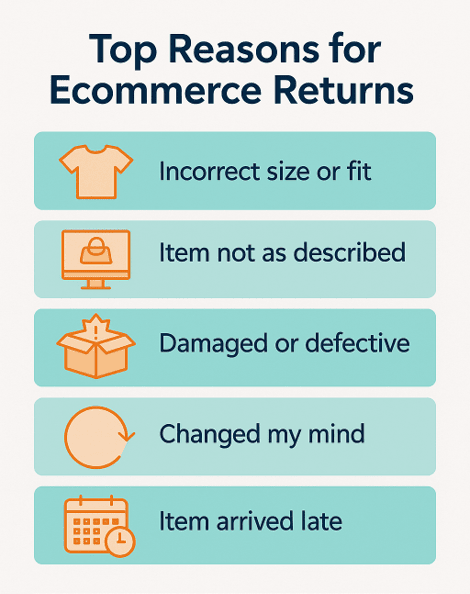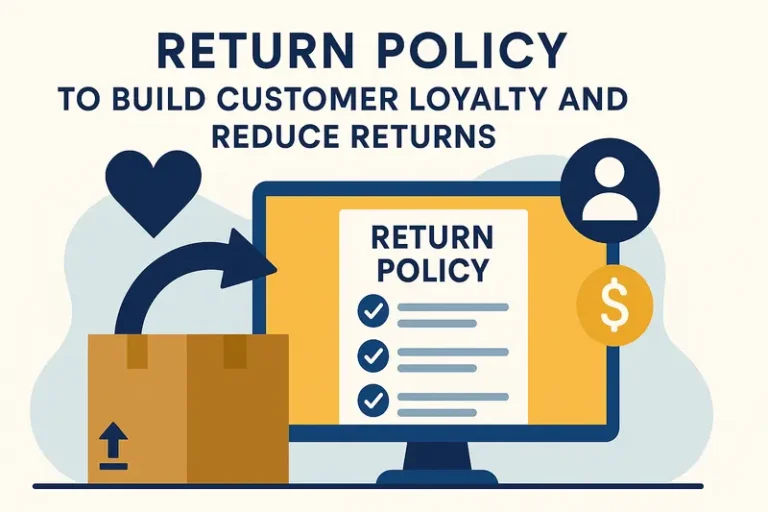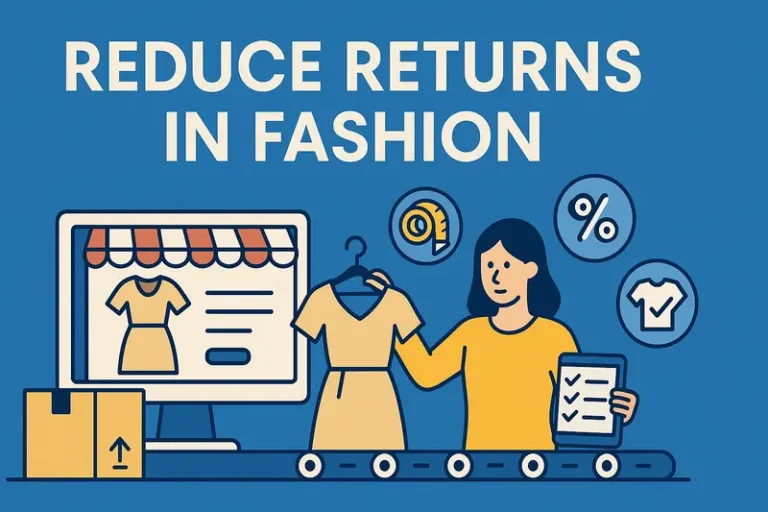How to Reduce Returns in Ecommerce and Boost Profits

Last updated on April 30, 2025

In this article
 11 minutes
11 minutes
- Key Takeaways
- Understand Why Customers Return Products
- Optimize Product Information
- Streamline the Returns Process
- Implement Technology Solutions
- Develop a Transparent Return Policy
- Learn from Industry Leaders
- Encourage Exchanges Over Returns
- Foster a Customer-Centric Approach
- Summary
- Frequently Asked Questions
Reducing returns in ecommerce directly impacts your bottom line and customer loyalty. In this article, we provide actionable strategies to help you achieve this. From understanding why customers return products to enhancing product descriptions, quality, and customer service, these techniques will help lower return rates. Learn how to reduce returns in ecommerce and create a seamless shopping experience for your customers.
Key Takeaways
- Understanding the reasons behind product returns, such as damage or inaccurate descriptions, is crucial for improving ecommerce processes and customer satisfaction.
- Implementing clear product descriptions, high-quality images, and accurate size guides helps customers make informed decisions, reducing return rates.
- Streamlining the returns process with self-service portals and transparent return policies enhances customer loyalty and satisfaction while minimizing operational challenges.
Understand Why Customers Return Products

Identifying why customers return products is essential for improving ecommerce processes. Common reasons include:
- Damaged items
- Incorrect items
- Poor product quality
- Issues with fit
- Inaccurate descriptions
- Delivery problems
These factors contribute to higher return rates. These returns not only impact profit margins but also affect customer satisfaction and loyalty. Recognizing these reasons allows businesses to create targeted strategies to reduce returns and improve customer experience.
Make Returns Profitable, Yes!
Cut shipping and processing costs by 70% with our patented peer-to-peer returns solution. 4x faster than traditional returns.
See How It WorksAddress Customer Dissatisfaction
Reducing customer dissatisfaction is key to minimizing returns. Collecting and analyzing feedback regularly helps identify issues with product quality, sizing, or other areas that need improvement. This feedback is crucial for understanding customer frustration and refining return policies.
Prioritizing customer satisfaction and delivering excellent service can help build loyalty and lower the chances of returns.
Improve Product Descriptions
Clear product descriptions set accurate customer expectations and reduce returns. Detailed information, such as specifications, dimensions, materials, and high-quality images, helps educate customers and make informed decisions. Videos or demos showcasing features can further enhance understanding and satisfaction.
Optimizing accurate product descriptions can greatly reduce potential returns.
Enhance Product Quality
High product quality is crucial for minimizing returns. Implementing stringent quality control before shipping ensures products meet high standards and are defect-free. This involves checking for damages and incorrect items to maintain customer satisfaction.
Focusing on product quality reduces returns due to defects and builds a reputation for reliability and excellence.
Optimize Product Information
Detailed and accurate product information is essential for reducing returns. Inaccurate descriptions, sizing discrepancies, and color variations often cause returns. Offering complete specifications and high-quality images helps customers make informed decisions and set realistic expectations. Optimizing descriptions is key to preventing returns.
Use High-Quality Images
High-quality images reduce returns by giving customers a clear view of products. High-resolution images from multiple angles help customers better assess and feel confident in their purchases.
Augmented reality features also help shoppers visualize products in their intended environment, reducing purchase uncertainty. Implementing these visual tools can lead to higher customer satisfaction and lower return rates.
Implement Size and Fit Guides
Detailed size charts and fit guides help customers make informed decisions and reduce return rates. Comprehensive charts and interactive size calculators engage customers and help them find their ideal fit. These tools minimize the likelihood of returns due to sizing issues.
Leverage Customer Reviews
Customer reviews add authenticity and set realistic expectations. They provide valuable insights and answer potential customers’ questions from buyers. Displaying reviews prominently on product pages offers social proof, helping customers make informed decisions and reducing returns. This social proof is essential for building trust and satisfaction.
Streamline the Returns Process
A seamless returns process enhances customer loyalty and satisfaction. Studies show that over 90% of repeat customers are likely to repurchase if the returns process is streamlined. Minimizing paperwork and steps can significantly simplify the process.
An efficient return process improves customer experience and helps manage returns effectively, especially when you need to process returns efficiently.
Offer Multiple Return Methods
Offering various return methods boosts customer convenience and satisfaction. In-store returns at brick-and-mortar stores and physical stores can increase confidence in future size decisions and provide opportunities for trying on other sizes. Happy Returns, with nearly 10,000 locations, simplifies the return process.
Effective communication channels like email, live chat, or phone support are essential for handling return inquiries promptly and clearly.
Utilize Self-Service Return Portals
Self-service return portals simplify the initiation and tracking of returns. User-friendly interfaces empower customers to manage returns independently, leading to higher satisfaction. Automated return processes streamline handling and reduce processing time.
Amazon uses automated systems to facilitate returns through self-service portals, enhancing efficiency.
Automate Returns Processing
Integrating return management software streamlines the returns process and reduces operational time. These systems make initiating and handling returns more efficient for both customers and businesses. Real-time inventory updates ensure accurate stock levels, reducing delays and improving satisfaction.
Combining return management software with real-time inventory updates significantly enhances operational efficiency and customer experience.
Convert Returns Into New Sales and Profits
Our peer-to-peer returns system instantly resells returned items—no warehouse processing, and get paid before you refund.
I'm Interested in Peer-to-Peer ReturnsImplement Technology Solutions
Technology solutions are vital for effective return management. A returns portal with checkout-like functionalities can streamline processing and enhance efficiency. Software like Happy Returns can significantly improve the returns process through reverse logistics.
Data-driven solutions and marketing automation tools can reduce ecommerce returns by enhancing personalized shopping experiences.
Use AI for Personalization
AI refines recommendations based on customer behavior and customer preferences, enhancing the shopping experience. This personalization helps customers find products that better meet their needs, reducing returns.
Leveraging AI provides a more tailored shopping experience, leading to higher customer satisfaction and fewer returns.
Monitor Return Fraud
Return fraud, including returning stolen items or falsely claiming non-receipt, is a significant issue when it comes to ecommerce returns. About 15% of retailers report substantial financial losses due to fraudulent return requests.
Retailers can combat return fraud by blacklisting serial returners and setting thresholds based on order values. Tools like Shopify Flow help accurately track and categorize different types of returns.
Real-Time Inventory Management
Real-time tracking systems allow continuous monitoring of inventory levels, ensuring timely updates. Accurate inventory management speeds up the return-to-stock process, enabling quick replenishment and meeting customer demands.
Accurate inventory management through real-time tracking improves operational efficiency and reduces stockouts and overstocks, ultimately minimizing returns.
Develop a Transparent Return Policy
A transparent return policy manages customer expectations and reduces returns. It should clearly outline conditions, timeframes, procedures, and any applicable return fees or restrictions.
Highlighting a clear return policy on each product page can increase conversions and reduce returns. A call to action and transparent communication during the returns process significantly boosts trust and satisfaction.
Define Clear Return Windows
Clearly defined return periods help mitigate misunderstandings and ensure customers know when to return items. This avoids confusion and ensures timely returns, enhancing satisfaction and reducing returns.
Offer Prepaid Return Labels
Prepaid return labels significantly ease the return process, especially for international customers. These labels mitigate challenges associated with extended delivery times and high shipping costs, making returns more convenient.
Offering prepaid return labels enhances customer satisfaction, reduces friction during returns, and can increase loyalty and brand affinity.
Learn from Industry Leaders
Learning from the return strategies of successful ecommerce brands offers valuable insights for enhancing satisfaction and boosting profits. Easy returns differentiate a retailer, presenting them as reliable and customer-friendly.
Adopting best practices from top brands like Zappos, Amazon, and Nordstrom enhances reliability and showcases a customer-centric approach. Embracing these strategies can boost profits and build strong customer loyalty.
Zappos’ 365-Day Return Policy
Zappos offers a 365-day return policy, allowing returns within a year of purchase and includes free return shipping. This liberal policy emphasizes customer satisfaction, ensuring customers feel confident and secure in their purchases.
This approach enhances Zappos’ brand image as customer-centric, fostering loyalty.
Amazon’s Automated Systems
Amazon uses AI technology to detect fraudulent return activities, mitigating potential losses. AI-driven fraud detection mechanisms minimize losses from fraudulent return claims.
Amazon’s return system employs AI to streamline processes efficiently, enhancing both efficiency and security. These automated systems contribute to Amazon’s reputation as a reliable and efficient retailer.
Nordstrom’s No-Time-Limit Returns
Nordstrom focuses on personalized service, allowing returns without a strict time constraint. This lack of a deadline fosters loyalty by creating a stress-free shopping experience. Fulfill your Nordstrom orders with free and fast shipping.
Nordstrom’s unlimited return policy, paired with attentive service, builds strong customer relationships and enhances satisfaction. This flexible approach helps maintain a loyal customer base and a strong brand reputation.
Encourage Exchanges Over Returns
Encouraging exchanges over returns retains purchase value and encourages repeat business. About 83% of ecommerce stores now offer an exchange option, significantly reducing inventory costs and improving cash flow in their ecommerce store, which can help lower the average ecommerce return rate.
Focusing on exchanges can improve customer loyalty and retention, leading to more sustainable marketing strategies and enhancing lifetime value.
Offer Store Credit
Store credit is an effective alternative to cash refunds, encouraging repeat business. It retains customers while allowing them to make future purchases with store credits.
Offering store credit increases retention as customers are likely to use credit on future purchases. This approach enhances loyalty and satisfaction, making it valuable for ecommerce businesses.
Incentivize Exchanges
Incentives for product exchanges can reduce return rates while maintaining satisfaction. Bonus credits for exchanges motivate customers to choose this option over refunds. Free shipping on exchanges removes barriers and encourages customers to opt for exchanges.
Extending the return window for exchanges compared to refunds can also incentivize customers to select exchanges, leading to fewer returns and higher customer satisfaction.
No More Return Waste
Help the planet and your profits—our award-winning returns tech reduces landfill waste and recycles value. Real savings, No greenwashing!
Learn About Sustainable ReturnsFoster a Customer-Centric Approach
A customer-centered approach in an ecommerce business emphasizes creating valuable experiences at every stage of the customer journey for ecommerce customers. Creating an efficient returns experience reduces losses, builds customer loyalty, and encourages repeat purchases. Ecommerce returns happen to be a crucial aspect of this process.
A flexible and hassle-free return policy can significantly encourage customer retention and transform a negative experience into customer loyalty. By focusing on customer satisfaction during the return process, businesses can foster long-term customer relationships.
Provide Outstanding Customer Service
Empathetic customer service can significantly reduce the likelihood of returns. Handling return inquiries with empathy can turn a negative experience into a positive one, enhancing customer satisfaction. For example, Zappos’ extended return period allows customers to feel more secure in their purchases, leading to higher satisfaction rates.
By prioritizing outstanding customer service, businesses can build customer loyalty and reduce returns.
Keep Customers Informed
Keeping customers informed about their return status enhances customer satisfaction and builds loyalty. Businesses should use multiple communication channels, such as email, Facebook Messenger, or SMS, to keep customers updated on the status of their returns.
Providing automated confirmation messages and estimated times of arrival for refunds when a returned parcel arrives at the warehouse can further enhance transparency and customer trust.
Gather Customer Feedback
Gathering and analyzing customer feedback is crucial for understanding their experiences and pain points in the customer returns process. Insights from customer ratings on the returns process can help businesses measure satisfaction and identify areas needing improvement.
By continuously gathering feedback and refining return policies based on analyzed data, businesses can better align with customer expectations and improve overall satisfaction.
Summary
In summary, reducing returns in ecommerce is a multifaceted approach that involves understanding the reasons for returns, optimizing product information, streamlining the returns process, and implementing technology solutions. By adopting best practices from industry leaders and fostering a customer-centric approach, businesses can enhance customer satisfaction, build loyalty, and boost profits. Implementing these strategies will not only reduce return rates but also create a more efficient and customer-friendly return experience.
Frequently Asked Questions
What are the common reasons for ecommerce returns?
Common reasons for ecommerce returns include receiving damaged items, ordering the wrong product, and encountering poor product quality. Understanding these factors can help improve customer satisfaction and reduce return rates.
How can accurate product descriptions reduce returns?
Accurate product descriptions effectively set customer expectations, leading to increased satisfaction and a reduction in returns. When customers know exactly what to expect, they’re less likely to be disappointed with their purchases.
What benefits do self-service return portals offer?
Self-service return portals empower customers to independently manage and track their returns, significantly enhancing their overall satisfaction. This simplification leads to a more efficient and positive experience for both customers and businesses.
How does offering prepaid return labels help customers?
Offering prepaid return labels simplifies the return process and minimizes hassle for customers, leading to increased satisfaction and confidence in their purchases. This proactive approach fosters a positive shopping experience.
Why is it important to keep customers informed about their return status?
It’s crucial to keep customers informed about their return status as it enhances satisfaction and fosters loyalty through transparency, ultimately reducing frustration.

Turn Returns Into New Revenue





